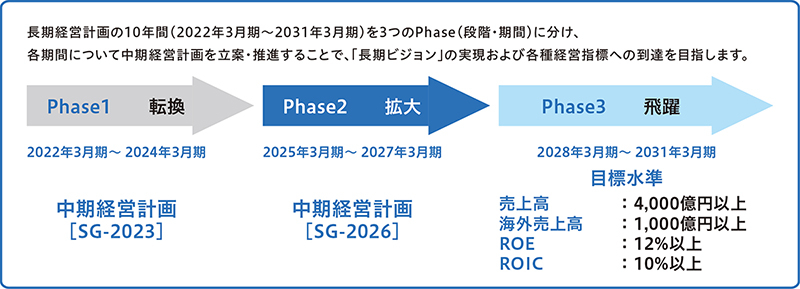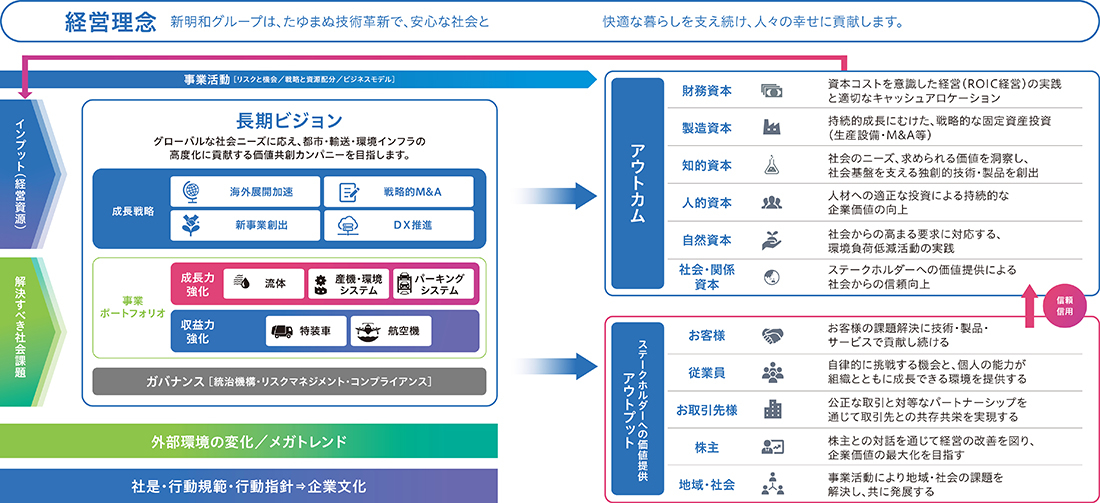長期・中期経営計画
In order to continue to grow sustainably after celebrating our 100th anniversary in 2020, our group has established Long-term vision for the future, with 2030 as the target year, based on Management philosophy.
Currently, we are conducting business activities in accordance with Corporate principles, Action guidelines, and Code of conduct in order to "contribute to the overall well-being of humanyty bringing unstinting innovation," as stated in our "Management philosophy." In order to realize our "Long-term vision," we are promoting "long-term-oriented management" by concretely defining what we want the Group to be and backcasting to close the gap between that vision and the current situation.
長期ビジョン
制定 2020年4月1日
経営理念に基づき、新明和グループが目指す2030年の姿を表したものです。
To respond to global society needs,
we will be a true value co-creation company that advances
urban, transportation and environmental infrastructures.
Long-term management plan
Sustainable Growth with Vision 2030 ([SG-Vision2030])
- Sustainable growth through value creation -
In order to continue achieving sustainable growth going forward, we will base our efforts on Management philosophy and set a future outlook with 2030 as our Long-term vision. By utilizing the management resources we have cultivated for over 100 years since our founding and the "six types of capital" we continue to accumulate through our business activities, we will strive to solve social issues and realize a sustainable future through our growth strategy (acceleration of overseas expansion, creation of new businesses, strategic M&A, and promotion of DX) and business portfolio strategy (providing value to stakeholders through five businesses).
Basic policy
The vision will be implemented with the following two management themes in parallel, improving corporate value by sustainably creating economic value and social value
- 1. "The Long-term business strategies": Lay out a future vision of society in 2030 and formulate and implement business solutions to achieve it
- 2. "Strengthening management foundations": Contribute to the SDGs through implementing sustainability management that supports Long-term business strategies
Promotion plan and target management indicators
The SG‐Vision 2030 period (FY2021 to FY2030) will be divided into three, with Medium‐term management plan for each period formulated and promoted, thus aiming to achieve the Long‐term vision and reach the various management indices.

Value Creation Process Conceptual Diagram

Medium-term management plan [SG-2026] <[SG-Vision2030] Phase2 “Expansion” >
[SG-2026] (fiscal year ending March 2025 to fiscal year ending March 2027) is Phase 2 "Expansion" of the Long-term management plan [SG-Vision 2030], which has a goal of fiscal year ending March 2031, and is positioned as the second step toward achieving our "Long-term vision" and will accelerate our growth.
In addition to resolving the issues that have already emerged in [SG-2023], we will work toward "Expansion" by implementing the six basic policies outlined below.
Basic policy
A)Acceleration of overseas expansion: Strengthening of expansion in Southeast Asia, Oceania, and North America
B)Strategic M&As:Active utilization of M&As, aiming to expand overseas and create new businesses
C)Promotion of DX: Value creation and new business model development by utilizing data
D)New business creation: New business creation through generating synergies among businesses and value creation with external parties
A)Classify the five businesses based on ROIC into a growth potential reinforcement business or profitability reinforcement business to manage the business portfolio
B)Investments and new business creation based on the portfolio classification to follow the [SG-Vision2030]
A)ROIC reverse tree implementation: Throughput increases, operating cost decreases, and substantial productivity improvements with all departments and group companies
B)Cash allocation: ROIC improvement through the investment strategy based on the business portfolio strategy and fund procurement in light of financial soundness
A)Recruitment and development of human resources based on the growth strategies: Digital literacy education, global human resource education, recruitment of highly professional human resources, and strategic human resource portfolio
B)Improvement of employee engagement: D&I promotion, career path formulation support for employees, and female leader development
A)Environment: Deployment of GHG emissions calculation for Scopes 1 and 2 and introduction of Scope 3 to group companies. Consideration of an environmental product certificate system
B)Society: Improvement of corporate value through expansion of values provided to stakeholders
A)Risk management:Monitoring of business risks arising from climate change and human rights issues and implementation of CSR, BCM/BCP※ measures, reinforcement of information security measures, etc.
B) Compliance: Continued implementation of compliance education and compliance awareness surveys, and enhanced utilization of internal reporting channels
- ※BCM:Business Continuity Management ※/BCP:Business Continuity Plan
Management Indicator
| Management Indicator | 2025年3月期(実績) | [SG-2026](Target standard) |
|---|---|---|
| Net Sales | 2,664億円 | 320 billion yen |
| Overseas sales | 451億円 | 80 billion yen |
| Operating Profit | 139億円 | 18 billion yen |
| ROE(%) | 8.2% | 10% or more |
| ROIC(%) | 6.0% | 7% or more |
| Exchange rate (1 US dollar) | 152.1円 | 140 yen (set value) |
| Segment | Net Sales | Operating Profit | ||||
|---|---|---|---|---|---|---|
| Fiscal year ending March 2025 (Achievements) |
[SG-2026] (Target standard) |
Growth rate | Fiscal year ending March 2025 (Achievements) |
[SG-2026] (Target standard) |
Growth rate | |
| 特装車 | 108,204 | 132.2 | 122% | 48 | 7.3 | 149% |
| パーキングシステム | 45,748 | 58.1 | 127% | 3.3 | 4.5 | 135% |
| Industrial Machinery & Environmental Systems | 33,270 | 43.5 | 131% | 22 | 3.4 | 154% |
| Fluid | 27,512 | 28.0 | 102% | 43 | 4.5 | 103% |
| 航空機 | 33,706 | 38.9 | 115% | 19 | 2.7 | 137% |
| Others | 18.0 | 18.3 | 102% | 14 | 1.0 | 68% |
| New businesses | ― | 1.0 | ― | -4 | -1.8 | ― |
| Adjustment | ― | ― | ― | -37 | -3.6 | ― |
| Total | 2,664 | 320.0 | 120% | 139 | 18.0 | 129% |
[SG-2026]Growth strategies
| Acceleration of overseas expansion | Strengthening collaboration between segments and alliances with local companies |
|
|---|---|---|
| New business creation | Taking on the challenge of creating new businesses: Led by the New the Business strategies Headquarters, we will promote "co-creation" by leveraging our "strengths" across segments. |
|
| Strategic M&As | Utilizing strategic M&A and creating value through co-creation |
|
| Promotion of DX | Business process reform | By standardizing and sharing value chain data, we will promote smarter operations and data aggregation, and build a "management platform" that enables information visualization and rapid decision-making. |
| Transform business model | Combining "customer data," "company data," and "open data," we will create new value through the use of AI/IoT and data analytics, and aim to transform our business model into one that provides solutions. |
[SG-2026]Business Portfolio Strategy
Aiming to leap from FY2027 towards the [SG-Vision 2030] goal
We will classify the five businesses based on ROIC into a growth potential reinforcement business or profitability reinforcement business to promote investment strategies as well as create new businesses through the synergy of the five businesses and value co-creation with external parties.




